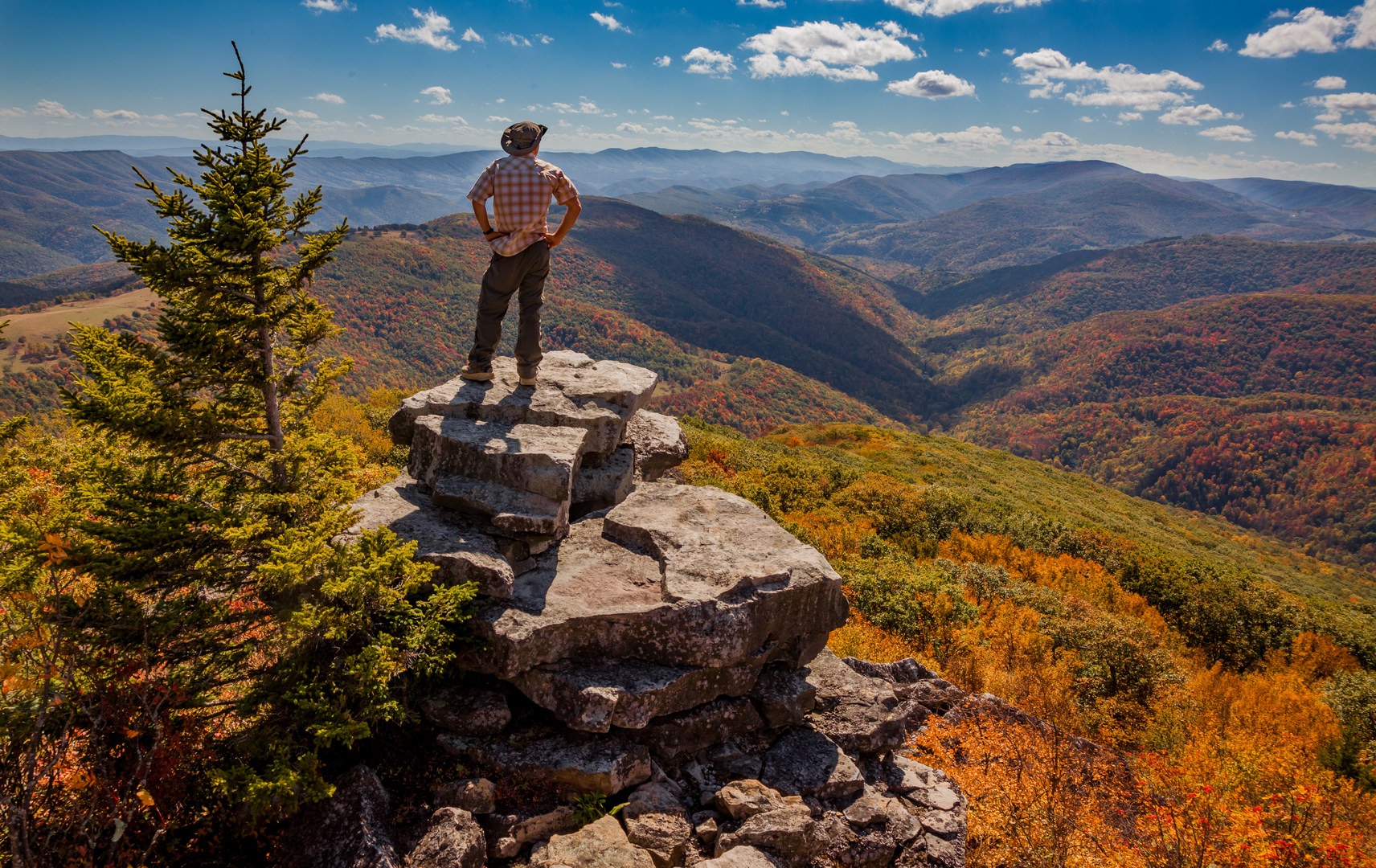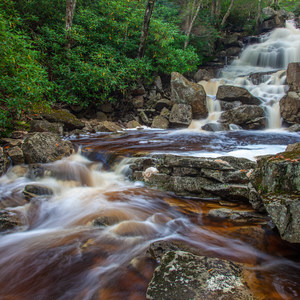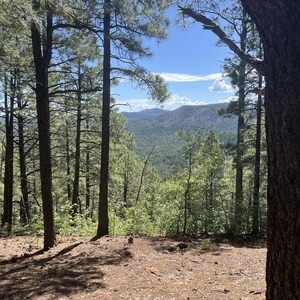You are here
This is really cool hike with grand 180- and 270-degree vistas from multiple rocky overlooks along the Eastern Continental Divide. It provides more solitude compared to the much more visited, but only slightly more spectacular Bear Rocks at Dolly Sods to the north. Cascading streams and beautiful forest trails exist deep in the canyon of the South Fork of Red Creek. Along rocky ridge tops are periodic open meadows reminiscent of the northern tundra regions of the Canadian Shield interspersed with Roaring Plain’s unique rock formations, bogs, red spruce forests, and mountain laurel and rhododendron groves. There are the official trails, Flat Rock Run, Roaring Plans, South Prong, and Boars Nest, but there are also several unofficial trails often referred to as Canyon Rim, Hidden Passage, Tee Pee and the Pipeline in some online descriptions. These unofficial trails can be easy to very hard to follow, but get you deep into the wilderness. This hike is a good introduction to what Roaring Plains can offer.
This is a hard hike due to the length, ups and downs, rocky-ankle-twisting trail treads, bushwhacking, and in places the “unofficial” trails are hard to follow. This there-and-back hike is roughly 11.6 miles. It is a long hike that could be done in a day for fit hikers with good navigation skills, but why? It’s too nice of a hike to rush through it. So if you have the time, do it as an overnight backpack. There are campsites and water at several locations along the route for most of the year. Good vehicle access is provided by FS 19 (a good dirt road, but low cars should be careful) with parking for five to seven cars at the Upper South Prong Trailhead (38.95859, -79.35942).
From the Upper South Prong Trailhead information sign, follow the blue blazed South Prong Trail over a series of boardwalks protecting the fragile bogs. Continue through Red Spruce and thick mountain laurel and rhododendron thickets, all interspersed with cool moss-covered sandstone rock formations. Along the trail are several hard-to-find side trails that lead to several overlooks. The first is at about mile 1.3 on the right side of the trail. Look for a faint side trail that takes you over a rocky opening with a view to the southwest overlooking Red Creek and Dolly Sods. It’s a good expansive view, but it has a cluttered foreground, making good panoramic photography difficult. The second is at mile 1.9 and is similar to the first. These viewpoints are described in early editions of Bruce Sundquist’s guidebook, “Monongahela National Forest Hiking Guide,” as sweeping views; it is now in its eighth edition. Also, most of the viewpoints are mapped on the hard-to-find maps produced by the “Bushwhackers” who hiked all the trails and bushwhack routes in the Dolly Sods and Roaring Plains area in the early 2000 time frame. But the rapid regeneration of the forest is quickly obscuring the foregrounds, making them harder to find and complicating the panoramic photographic opportunities along the South Prong that used to exist.
At about 2.3 miles the trail will enter one of the several open meadows and start a gradual turn toward the right (west, then west-northwest) away from its general south-southwest course. At about mile 2.5 (38.93260, -79.36568) is a rock cairn that marks the start of the “Hidden Passage,” an unofficial trail that is gaining in popularity and usually not too difficult to follow. Go left onto Hidden Passage because continuing straight on the South Prong Trail will take you toward FS70 (closed year round except for fall hunting session), and then the steep descent into the depths of the South Fork of Red Creek.
After the left turn onto Hidden Passage you will find a small creek that usually has water in all but the driest seasons. Near it is a small isolated campsite (38.93209, -79.36626). Look carefully to follow the trail because there are a few short side trails in the area. Follow the most obvious path. From the trail junction with Hidden Passage, continue through the stunning forest of periodic fern and mountain laurel thickets and open meadows for about 1 mile. Then you crest an open meadow as you arrive at the edge of the Eastern Continental Divide with its sweeping 180-degree plus views. Here is one simple dry campsite with a fire ring. In an additional few hundred yards is another dry campsite (38.92008,-79.37629) with rock benches where you can sit and take in the stunning topography and beauty of North Fork Mountain to the southeast with the famous Seneca Rocks visible in the valley below. Seneca Rocks is one of the premire mid-Atlantic traditional rock climbing areas. If you are backpacking, consider this a great overnight site for sunsets and sunrises.
Continue along Hidden Passage as it leaves the views of the escarpment and weaves its way through the open meadows toward the west, finally ending at the Pipeline unofficial trail in about 0.4 miles. The Pipeline is a scar of a buried natural gas line the cuts the area, preventing all the area north and east of it to FS19 from being included in the Roaring Plains Wilderness. At the Pipeline, turn left (south) and start the steep, but short descent toward the unofficial Canyon Rim Trail. In less than a half of a mile you will come to a small unnamed and often dry creek that feeds into Roaring Creek. Cross it and on your right will be the start of the Canyon Rim Trail (38.91577, -79.38143).
There is a short option here before starting the Canyon Rim Trail. Doff your packs and continue 0.3 more miles down the pipeline to a faint trail on the right (38.91322, -79.38031), which takes you to a to a nice little overlook. When done, retrace your steps back to your packs and start the Canyon Rim Trail.
In the beginning, the obscure Canyon Rim can be a frustrating trail to follow due to its leaf covered trail tread and thick brush at various locations. You shouldn’t get lost brcause it closely follows the escarpment of the Eastern Continental Divide. After turning right off the Pipeline and entering the forest there will be a small campsite. Stay to the right of the site, don’t go straight through the site, and re-cross the unnamed creek. Quickly the tread will become more obvious. Continue following it. Soon it will break out into a meadow (boggy in the wet seasons). Stay on the left, downhill side. Re-enter the forest. Again, after about 0.4 miles from the start of Canyon Rim, the trail will again become difficult to follow again for about 300 yards. But be patient. It is hard to get truly lost because it follows the edge of the escarpment as it works its way around the Roaring Creek Canyon, first in a west-northwest, then west and finally a southwest direction. Use a GPX track that can be found online. The best source can be pulled off the Mid-Atlantic Hikers website. In this section, there are several small runs, some wet, some dry, which drain into Roaring Creek. Finally, after about a half of a mile from the start of Canyon Rim you will come to the steep Roaring Creek (38.91533, -79.39212) with its reliable source of water. This is the last water before arriving at The Point. From Roaring Creek it is about 0.5 miles to The Point with its stunning un-obscured 270-degree views. From Roaring Creek, the trail goes nearly due south to The Point.
On the way to The Point you will cross another talus field of rocks. Fortunately, the trail is marked with a few cairns. After clearing the talus field, there will be an easy to see side trail (38.91384, -79.39179) to left that takes you to a great viewpoint in several hundred yards with views into the Roaring Creek Canyon you just circled around. Return to the main trail and continue south (hiker's left).
When you arrive at The Point, make sure you walk the faint trail to the two rock outcroppings due south and scramble to the top of each. The view is stunning, complete with uncluttered foreground, great for photo panoramas and selfies on top of the rocks with a deep chasm behind you followed by endless ridgelines. Fall danger is real from the top, so do be careful!
Camping is very limited around The Point due to the rocky and thickly covered forest floor. However, in a pinch, a small dry camp with no fire can be made. Turn around here and retrace your steps unless you want to close the loop with an optional longer and tougher hike. The option is to continue along Canyon Rim. There are some established primitive campsites farther along Canyon Rim Trail. If you continue you intercept the Tee Pee Trail (38.91991, -79.41036), that will link you back to the official Roaring Plains Trail to complete the loop. Travel beyond The Point is difficult and requires excellent navigation skills since the faint and over grown Tee Pee Trail can be hard to find and follow without GPS. Again, Mid-Atlantic Hikers can provide a GPX track.











Comments
Sign In and share them.